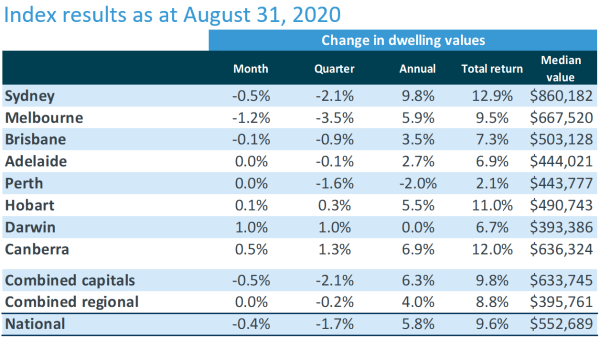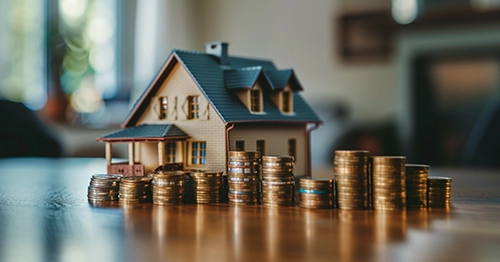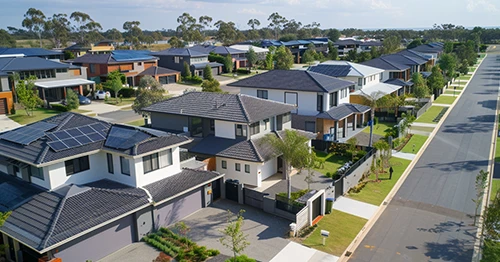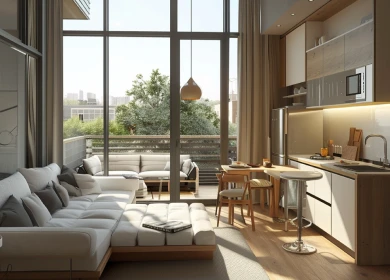Updated: 09 May, 2025
CoreLogic reveals that Australia’s property market is experiencing a fourth consecutive month of COVID-induced price falls, with home values dipping by 0.4% in August. However, home values for the 12 months to August 31, 2020, are still 5.8% higher than in 2019. Even where housing values are trending lower than their pre-COVID highs, the rate of decline over the past two months has eased.
How did Australia's property market perform in August 2020?
Apart from Melbourne, the performance of other capital cities was better when compared to July 2020. While Melbourne recorded a 1.2% decline, Sydney and Brisbane only experienced a decline in home values of 0.5% and 0.1% respectively. Other capital cities experienced a slight increase, with a 1% increase in Darwin’s home values in August 2020.
According to CoreLogic’s head of research Tim Lawless, “The performance of the housing markets are intrinsically linked with the extent of social distancing policies and border closures which also have a direct effect on labour market conditions and sentiment. It’s not surprising to see Melbourne as the weakest housing market considering the extent of the virus outbreak, and subsequent restrictions, which have weakened the economic performance of Victoria.”
Auction results show the combined capital city clearance was in line with a decade average of 59% during the first three weeks of August. While the overall trend is strong, the two largest auction markets – Sydney and Melbourne – tell different stories. Melbourne auction volumes were the lowest level since April 2020. Sydney’s clearance rates have held above 60% since mid-May while Melbourne has softened at an average of 54% in August. Lower quartile home values are still performing better than upper quartile home values. Across combined capitals, lower quartile home values rose 0.1%, while upper quartile values fell 0.9%. Capital city rents have held up better than housing values. Capital city dwelling rents declined by 1.4% (since the end of March), compared to a 2.3% decline in dwelling values. However, there is a vast difference in rents for houses and units. Since the end of March, house rents were down by just 0.3% compared to a 3.5% decline for unit rents. There is an approximately 3% difference between house rent and unit rent between Sydney and Melbourne.
Another hit on Melbourne's property market
Melbourne, which has been in stage 4 lockdown, saw prices fall 1.2% in August which is the biggest fall recorded among the capital cities. Throughout the COVID-19 period from March 2020 till August 2020, Melbourne’s home values dropped by 4.6%. The decline shows the impact of the resurgence of COVID-19 cases and the demand side impact of stalled migration from overseas. Melbourne also held the lowest number of auctions since May 2020. There have been just 167 auctions across the city, 49.6% of them successful, compared to last year when 768 homes were auctioned with a clearance rate of 74.4%. The high withdrawal rate and the low number of auctions could mean that vendors do not want to take a risk on Melbourne’s property market during the lockdown period.
Demand is booming in regional markets
Demand is increasing for regional real estate, as more people look towards remote working. CoreLogic data saw regional markets unchanged over August, and they were down just 0.1% over the past 3 months. Regional markets also receive only 15% of net overseas migration, so they have avoided the large drop in demand caused by the pause in migration. The regional property market has been more appealing to buyers because of:
- The low density
- The lower price points
- The flexibility that comes with remote work which the pandemic has normalised.
In a post-pandemic world, Australians would prefer to live in low-density areas. Westpac research reveals 77% of respondents prefer to live in houses due to COVID-19, while just 22% prefer to live in inner-city or urban areas.
In summary
There is a clear difference in how the housing market reacts where the COVID-19 curve has flattened or peaked, highlighting the broad economic impact of renewed social distancing policies, border closures and weaker consumer sentiment. The spring selling season will be slower than usual. New and total listings are decreasing, and sales activity has slipped by 1.9% in August. While there is no evidence of distressed properties coming on the market, It’s a case of waiting to see what happens once government stimulus ends and lenders do their six-month check-in for borrowers who took repayment holidays. If you’re looking to buy your home, our mortgage brokers are here to help. Call us on 1300 889 743 or fill in our free assessment form.






